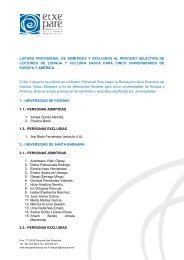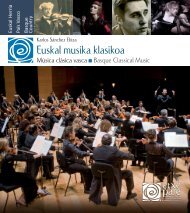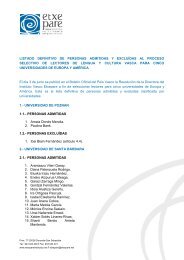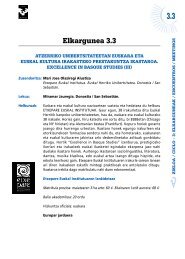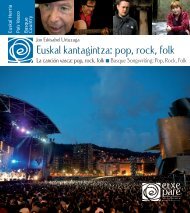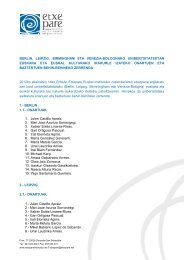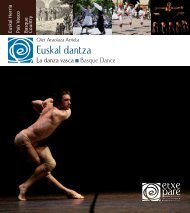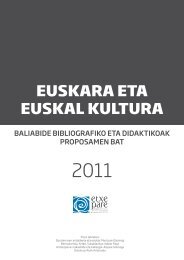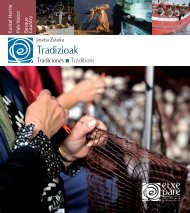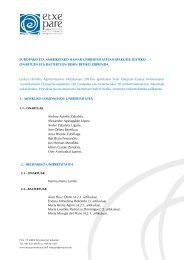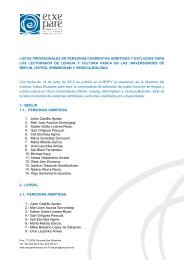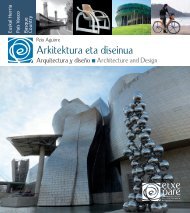XX. mendeko euskal literatura - Etxepare, Euskal Institutua
XX. mendeko euskal literatura - Etxepare, Euskal Institutua
XX. mendeko euskal literatura - Etxepare, Euskal Institutua
You also want an ePaper? Increase the reach of your titles
YUMPU automatically turns print PDFs into web optimized ePapers that Google loves.
Egunero hasten delako de Ramón Saizarbitoria<br />
(1944), publicada en 1969, introdujo modelos experimentalistas<br />
en la <strong>literatura</strong> vasca. Organizada<br />
en dos planos narrativos independientes que se van<br />
alternando, la novela cuenta la historia de una joven<br />
estudiante que quiere abortar y la conversación que<br />
tiene lugar en una estación de ferrocarril y una central<br />
telefónica entre un personaje extraño y uno o varios<br />
interlocutores anónimos. La segunda novela del<br />
autor, 100 metro (1976), es su obra más traducida y<br />
fue llevada al cine en 1985 por Alfonso Ungría. También<br />
en Ehun metro el narrador recurre a diferentes<br />
planos narrativos aunque en esta novela es más evidente<br />
el uso de técnicas cinematográficas a la hora<br />
de relatar los acontecimientos. La historia principal<br />
narra los últimos cien metros de un activista de ETA<br />
antes de ser abatido por la policía en la Plaza de la<br />
Constitución de San Sebastián. La novela describe el<br />
ambiente de los últimos años de la dictadura franquista,<br />
un período de gran represión política. Saizarbitoria<br />
compuso su tercera novela, Ene Jesus (1976),<br />
valiéndose de las técnicas de la Nouveau Roman.<br />
Bernardo Atxaga (1951) y Koldo Izagirre (1953) fueron,<br />
junto a Saizarbitoria, grandes impulsores de<br />
modelos experimentales. En 1975 Atxaga e Izagirre<br />
publicaron la revista Panpina ustela. En el manifiesto<br />
que hizo público la misma, “Ez dezagula konposturarik<br />
gal, halere” (no perdamos la compostura, de<br />
todas maneras), los autores criticaban la situación de<br />
la <strong>literatura</strong> vasca y abogaban por un cambio radical.<br />
Ejemplos de ese cambio son los textos neovanguardistas<br />
Zergatik bai (1976) de Izagirre y Ziutateaz<br />
(1976) de Atxaga. Ambos trabajos cerraron el capítulo<br />
experimentalista de la década de 1970.<br />
Tras la ratificación de la Constitución española en<br />
1978, el euskera pasó a ser co-oficial junto al castellano<br />
en las dos comunidades vascas peninsulares,<br />
es decir, en la Comunidad Autónoma Vasca y en la<br />
Comunidad Foral de Navarra. Ello posibilitó que a nivel<br />
educativo se pudieran ofrecer modelos bilingües<br />
Urturik recounts the suffering of the town’s inhabitants<br />
following some floods. The recurring image of a<br />
spider’s web appears throughout the book as a symbol<br />
of the repression being suffered by Basques at<br />
the time. The influence of magic realism is evident in<br />
the allegorical novel Haurgintza minetan (1973) by<br />
Mikel Zarate (1933-1979) and in Oilarraren promesa<br />
(1976) by Joan Mari Irigoien (1948). Both works denounced<br />
the political repression in the peninsular<br />
Basque Country.<br />
Egunero hasten delako by Ramón Saizarbitoria<br />
(1944), published in 1969, introduced experimentalist<br />
models into the Basque novel. Organised along<br />
two independent alternating narrative levels, the<br />
novel tells the story of a young student who wants<br />
to have an abortion and the conversation that takes<br />
place in a train station and telephone exchange between<br />
a strange person and one or several anonymous<br />
interlocutors. The author’s second novel, 100<br />
metro (1976), has been translated more and was<br />
made into a film in 1985 by Alfonso Ungría. Similarly,<br />
in 100 metro the narrator resorts to different narrative<br />
levels although in this novel the use of cinematographic<br />
techniques is more evident when relating the<br />
events. The main story narrates the final one hundred<br />
metres of an ETA activist before being shot dead<br />
in Constitution Square in Donostia-San Sebastián.<br />
The novel describes the atmosphere during the final<br />
years of the Franco regime, a period of major political<br />
repression. Saizarbitoria wrote his third novel,<br />
Ene Jesus (1976), making use of the techniques of<br />
the Nouveau Roman.<br />
Bernardo Atxaga (1951) and Koldo Izagirre (1953)<br />
were, together with Saizarbitoria, the main exponents<br />
of experimental models. In 1975 Atxaga and<br />
Izagirre published the journal Panpina ustela. In its<br />
public manifesto which declared that, “Ez dezagula<br />
konposturarik gal, halere” (anyway, we shouldn’t lose<br />
our composure), the authors criticised the situation<br />
of Basque literature and advocated radical change.<br />
23



